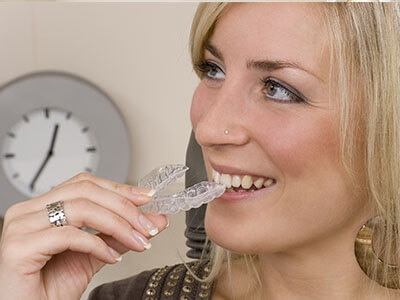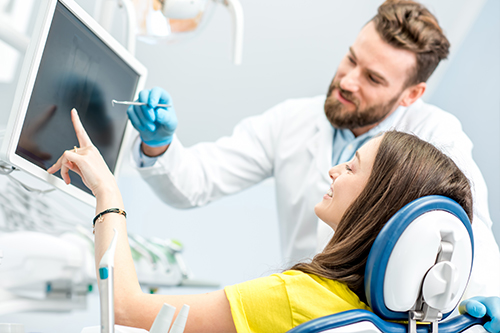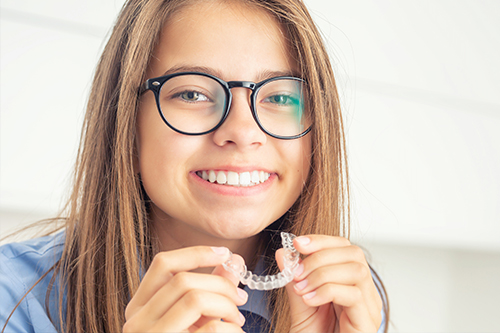Invisalign® for Teens

Our Office
Visit Us Online

Invisalign® offers a modern, discreet alternative to traditional braces — a way to straighten teeth that fits into real life without calling attention to itself. Built from nearly invisible, removable aligners, the system is designed to move teeth precisely over time while preserving everyday routines like eating, speaking and oral hygiene. For many adults and teens, that combination of discretion and control makes Invisalign® an appealing option.
At A Center for Dental Excellence, our approach to aligner therapy emphasizes careful planning, consistent clinical oversight, and patient comfort. We use the latest digital tools to create individualized treatment pathways so each set of aligners performs exactly as intended. Below, you’ll find deeper, practical information about how Invisalign® works and what patients typically experience during treatment.
Invisalign® treatment is based on a series of custom thermoplastic trays that gently guide teeth from their starting positions toward the planned final positions. Each tray is designed to produce small, controlled movements. Patients typically wear a single aligner for about one to two weeks before moving to the next in the sequence, so the overall change happens gradually and with minimal discomfort.
Precision begins with an accurate diagnosis and a detailed digital plan. Modern 3-D imaging and digital scanning capture tooth and bite relationships with high fidelity, allowing clinicians to visualize every stage of movement before the first aligner is made. That planning stage is critical: it determines the number of aligners needed and whether adjuncts like attachments or elastics will be used to achieve specific tooth roles.
Because each aligner only moves teeth a fraction of a millimeter at a time, the forces are gentle and sustained. This helps reduce soreness compared with some traditional orthodontic adjustments. The removable nature of the appliances also supports better oral hygiene throughout treatment, which contributes to healthier gums and smoother progress toward the planned outcome.
A successful Invisalign® outcome depends on the combination of Align Technology’s planning software and the judgment of a trained dental professional. Clinicians use a digital treatment simulation — often called a ClinCheck or interactive treatment plan — to map each tooth’s movement from start to finish. This simulation can be reviewed and adjusted before manufacturing begins, letting the provider anticipate challenges and refine the path of movement.
During planning, the team evaluates whether attachments (small composite shapes bonded to selected teeth), interproximal reduction (minor enamel adjustments), or auxiliary elastics will be necessary. These measures help the aligners achieve movements they cannot accomplish alone, such as root torque or significant rotation. The clinical team’s decisions at this stage influence comfort, timing, and predictability.
After the plan is finalized, a laboratory processes the digital prescription into a staged series of aligners. Although much of the workflow is digital, ongoing in-person oversight is essential. Periodic check-ins allow your provider to confirm tooth movement is following the plan and to intervene quickly if refinements are needed. This partnership between technology and clinical expertise is what makes contemporary aligner therapy effective.
One of Invisalign®'s biggest appeals is convenience. Aligners are removable, which means routine meals, sports participation, and oral care are unaffected for most people. Patients are typically advised to wear the trays for a prescribed number of hours per day to maintain consistent force on the teeth; compliance is the single most important factor in an efficient, trouble-free treatment timeline.
Maintaining good oral hygiene is simpler with removable aligners. Brushing and flossing between meals prevents plaque buildup and reduces the risk of staining or gum inflammation. Aligners themselves should be cleaned gently according to the manufacturer’s and clinician’s recommendations, usually with a soft brush and approved rinsing solutions or cleaning crystals designed for clear appliances.
Comfort and speech adapt quickly for most patients. Slight changes in pronunciation may occur for a few days after starting a new aligner, but these usually resolve as the tongue and lips adjust. Discomfort after switching to a new tray is normal and typically short-lived; over-the-counter pain relievers and soft foods can help during the first 24–48 hours if needed.
Invisalign® aligners are made from medical-grade thermoplastic that is biocompatible and designed for daily wear. The system has been refined through years of clinical experience and extensive data collection, and it is cleared by regulatory authorities for use in a wide range of orthodontic situations. Nonetheless, successful treatment depends on the right case selection and a proper clinical plan.
Ideal candidates include people with mild to moderate crowding, spacing, and many common bite concerns. More complex skeletal discrepancies or severe malocclusions may require combined approaches or referral to a specialist. During an initial evaluation, your dental team will assess tooth movement possibilities, periodontal health, and any restorative needs that could affect aligner performance.
Because aligners are removable, patients must be willing to follow the wear schedule and care instructions. Those who travel frequently, participate in contact sports, or have dental restorations can often still benefit from aligners, but candidacy and the precise protocol should be discussed at the consultation.
Regular monitoring is a cornerstone of effective aligner therapy. Scheduled visits allow clinicians to verify that teeth are tracking according to the plan and to make adjustments if unexpected movement occurs. In some cases, supplemental aligners or refinement stages are recommended to perfect the final result; these are part of a responsible clinical program rather than a sign of failure.
Once active alignment is complete, retention is essential to preserve the result. Your provider will recommend a retention strategy — usually a removable retainer or a bonded appliance in specific situations — tailored to your bite and lifestyle. Adhering to retention guidance is the most reliable way to maintain the new tooth positions over time.
Safety also includes attention to oral health: healthy gums and adequate bone support are prerequisites for tooth movement. If periodontal issues or significant restorations exist, these are addressed before or in coordination with aligner therapy to protect long-term outcomes.
Learn more about the practical aspects of aligner treatment through short, informative videos and clinical demonstrations.
*Invisalign® is a registered trademark of Align Technology, Inc.

Your first appointment focuses on a thorough clinical exam and discussion of goals. We’ll review oral health, take digital records, and outline realistic treatment possibilities so you can make an informed decision.

A fast digital scan replaces traditional molds for most patients. That scan becomes the basis of a step-by-step plan that maps each aligner stage and provides a visual preview of the intended result.

The aligners are manufactured to match the digital prescription and are trimmed and finished for a comfortable fit. Small auxiliary features may be added to the acrylic to enhance control where needed.

From the first aligner through the final refinements, your clinical team monitors progress, answers questions, and adjusts the plan when necessary to ensure safe, effective movement.
Invisalign® represents a combination of advanced materials, digital planning and clinician oversight that makes clear aligner therapy a reliable option for many patients. If you’re considering orthodontic improvement but want a solution that fits into everyday life, reach out to learn more about how aligners could work in your situation. Contact us for additional information or to schedule a consultation.
There are many options for patients who want to avoid metal braces! The most popular alternative orthodontic treatment is Invisalign®, which are clear plastic aligners designed to straighten teeth. After an examination of your teeth, your dentist will determine which option is best suited to your wants and needs.
According to the Invisalign® website, the cost for treatment is approximately the same as the cost for metal braces. A portion of this cost may be covered by your insurance. Please call us to set up a consultation and discuss potential payment plan options.
The first step is to schedule a consultation with your doctor, so they can devise a treatment plan that is best suited to your individual dental needs. Once approved, you will receive your first set of aligners. Your doctor will then regularly monitor the movement of your teeth and new aligners will be ordered according to the progress made in your treatment plan.
Invisalign® aligners are made of clear, flexible plastic. The company received a patent for this material – SmartTrack® – to be used exclusively for Invisalign treatment purposes. These aligners are FDA approved and nearly invisible!
Your doctor will give you an estimate regarding how long your Invisalign® treatment should take, which will depend on your specific needs. The average length of time for treatment is approximately 12-18 months. However, some patients may see results far sooner. Remember to wear your aligners exactly as instructed by your doctor to obtain the best results.
Your doctor will most likely recommend that you wear retainers following your Invisalign® treatment. This is a precaution that will prevent your teeth from shifting back to their original positioning. It is important to follow your doctor's instructions exactly to ensure long-lasting results.
You must wear your aligners for up to 22 hours daily. You may remove them for eating, drinking and regular oral hygiene.
No. Unlike braces, you may eat whatever you like as long as you remove the aligners before eating. Prior to placing the aligners back on, it is important to brush your teeth and the aligners after you eat.
Like any orthodontic treatment, there is a short adjustment period. The more you speak with the aligners on, the quicker you will adjust.
There will be some pressure and minor discomfort for a day or two after each initial insertion. This is a sign that your teeth are moving sequentially into their final position.
It is recommended that you remove your aligners prior to chewing gum as the gum will stick to the aligners.
We discourage smoking with aligners as the cigarette smoke will tend to discolor them.
Brushing them with toothpaste will keep them fresh and clean.
Regular office visits are every five to six weeks. This will ensure that your Invisalign treatment is progressing as planned.
All orthodontic patients are instructed to wear their retainers at night indefinitely. Sleeping with your retainers in at night will ensure a healthy bite and maintain the new position of your teeth.
Yes, if their teeth, including second molars, have grown in completely.
Let A Center For Dental Excellence help you maximize your insurance benefits. Our expert staff will work with you to make sure you get the most from your insurance, while also getting optimal health benefits from your dental plan. We work with most insurance dental plans. We strongly recommend you list your insurance information to minimize your wait time in the office. If you have any questions or want to book an appointment, contact our staff in Brooklyn at (718) 232-8289 or in Staten Island at (718) 980-9555 and we will assist you.